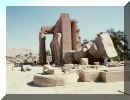
![]()
|
|
|
|
|
 |
The narrator tells how he heard a story from a traveller who saw the ruins of the statue of Pharoah Ramses II (Ozymandias) in the desert. He describes the heartless and cruel expression on the statue’s broken face and Ramses boast (carved on the base of the statue). His boast is ironic and becomes laughable because of the setting - all his accomplishments have disappeared.
The point of the story is the irony: the shocking contract between what we expect a powerful man like Ramses II to leave as a legacy and the endless emptiness that is actually there - 5000 years have almost destroyed everything. We now laugh at his scorn and his boast to be God (king of kings). Shelley also points out how relevant this lesson is for modern potentates.
You must be able to pick out Ramses’ boasts and how time has destroyed each one of them.

Picture courtesy of http://www.bluffton.edu/~sullivanm/egypt/thebes/ramesseum/ramesseum.html
British colonialism in Africa
Doris Lessing's story is set in British colonial Africa and deals with the conflicts colonials had to face there. The main characters are white farmers (the black characters don't even get a name) in a mostly black and hostile continent, and they feel strangely out of place. At the time this story was published, many of the former colonies were being given or were taking their Independence by force and the former colonists seemed somewhat overwhelmed by the force of history. However, while it is a battle of groups, Margaret doesn't see the battle as personal since Richard carefully frees the locust from his pocket "as if he would not harm a hair of his head."
Harshness of the African setting
Africa is not easy land to farm. Constant plagues, periodic droughts, veld fires, army worms, floods, frosts etc, take their toll. Then there is the shortage of technology and skilled labour which, together with the heat, make it a constant battle to survive. In fact, the war against nature seems to be a central theme in the whole African experience, but it is softened by the rare natural beauty of Africa - just look at the colours Margaret describes at the end of the story, the remoteness and peacefulness that they recognise. Richard and Old Stephen might have lived there for a long time and battled successfully against all kinds of troubles, but still expect more trouble since they end the story with, "It could have been worse, it could be much worse."
Literary tradition of locusts
The isn’t the first story of locusts in Africa. Up north in Egypt, locusts were one of the plagues visited on Pharoah Ramses II in order to persuade him to free his Israelite slaves (the Moses story). The locusts are also compared to two other plagues (hail, darkness, and flood). The plagues passed and the slaves were still in Egypt; this plague passes and the Africans still work for their white farmers. The parallels in the stories are tempting to explore. The locusts moved from the north to the south like the African independence movements. The white farmers have to work together with the government to fight the swarms of black and rust coloured locusts that settle on everything and destroy their farms.
There is also an strong suggestion of a prophecy when Richard and Stephen talk about eating locusts, almost like John the Baptist ate locusts during his days in the wilderness. The prophecy seems to suggest a natural law that slaves will escape their masters.
Women’s expression and role in a patriarchal (male dominated) society
Margaret has a problem in this story: she is the only woman in a male controlled (patriarchal) family and has only been on the farm three years while her father-in law has farmed there for forty. She seems confined to the kitchen and the house during the whole episode and seems to come to accept her different life on the farm. However, she has the power of choosing how to tell the story and is able to evaluate all the characters and the setting – farmer and servant, black and white.
Please don't forget that while the story is set in southern Africa, it contains references to the whole of Africa and, by implication, to injustice everywhere.
|
Questions or problems regarding this web site should be directed to
disenglish@hotmail.com.
|